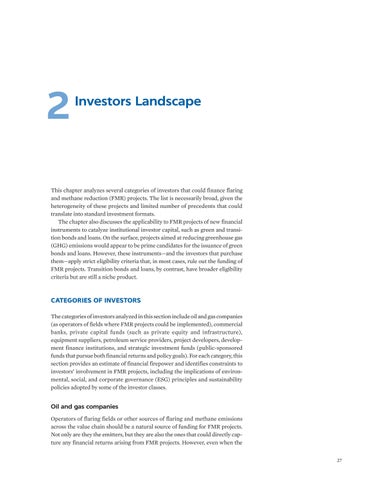2
Investors Landscape
This chapter analyzes several categories of investors that could finance flaring and methane reduction (FMR) projects. The list is necessarily broad, given the heterogeneity of these projects and limited number of precedents that could translate into standard investment formats. The chapter also discusses the applicability to FMR projects of new financial instruments to catalyze institutional investor capital, such as green and transition bonds and loans. On the surface, projects aimed at reducing greenhouse gas (GHG) emissions would appear to be prime candidates for the issuance of green bonds and loans. However, these instruments—and the investors that purchase them—apply strict eligibility criteria that, in most cases, rule out the funding of FMR projects. Transition bonds and loans, by contrast, have broader eligibility criteria but are still a niche product.
CATEGORIES OF INVESTORS The categories of investors analyzed in this section include oil and gas companies (as operators of fields where FMR projects could be implemented), commercial banks, private capital funds (such as private equity and infrastructure), equipment suppliers, petroleum service providers, project developers, development finance institutions, and strategic investment funds (public-sponsored funds that pursue both financial returns and policy goals). For each category, this section provides an estimate of financial firepower and identifies constraints to investors’ involvement in FMR projects, including the implications of environmental, social, and corporate governance (ESG) principles and sustainability policies adopted by some of the investor classes.
Oil and gas companies Operators of flaring fields or other sources of flaring and methane emissions across the value chain should be a natural source of funding for FMR projects. Not only are they the emitters, but they are also the ones that could directly capture any financial returns arising from FMR projects. However, even when the 27


